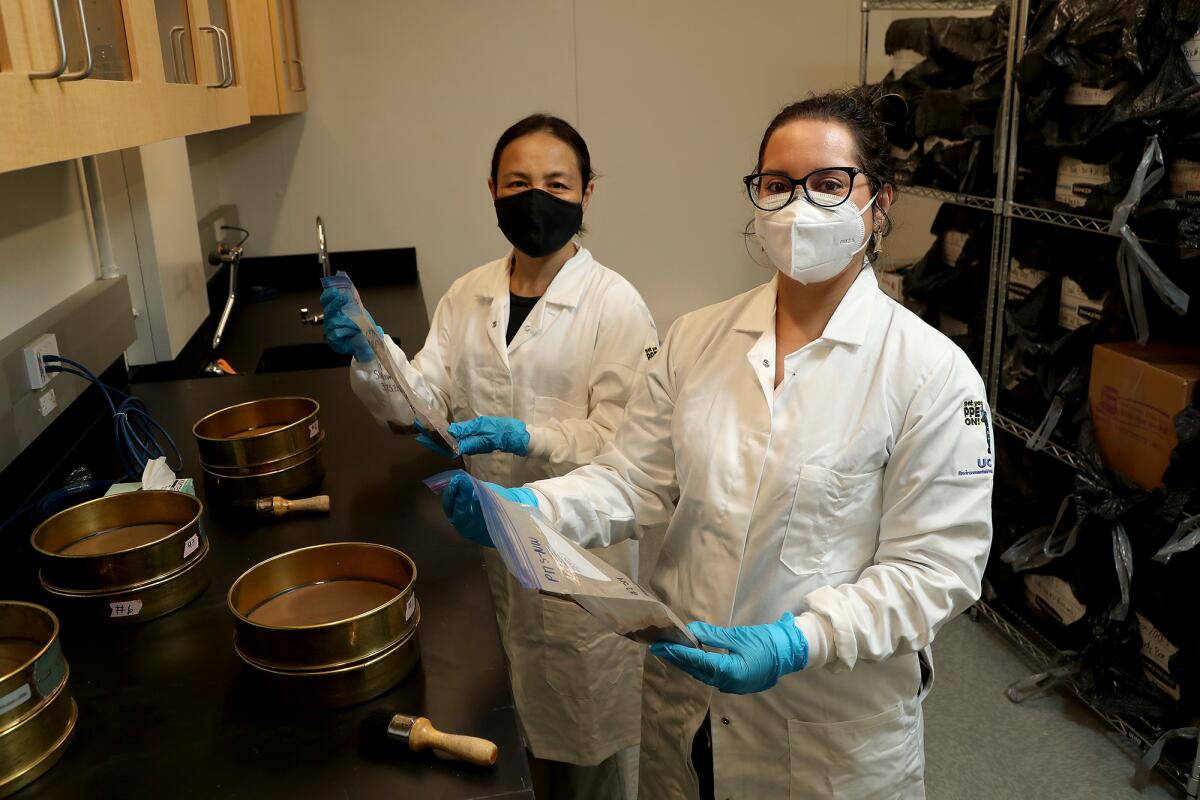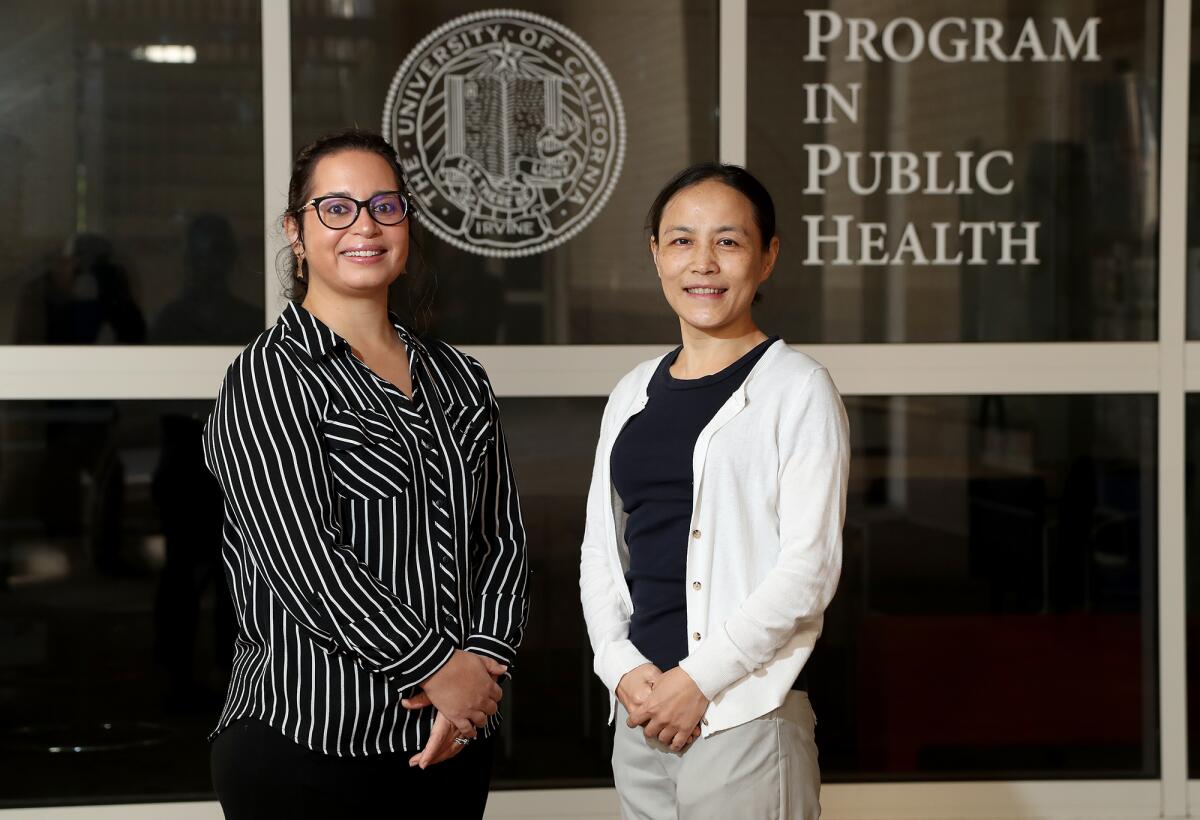UCI center will dig into environmental justice issues in Orange County’s vulnerable communities

As climate change threatens to worsen environmental health disparities in vulnerable communities, UC Irvine has started a center dedicated to researching and advancing environmental justice issues.
Public health professors Jun Wu and Alana LeBrón will lead the center. Both have worked with vulnerable communities in Orange County in recent years to test air quality and lead in neighborhood soils. They plan to incorporate that community focus into the center by seeking out local partnerships and forming a community advisory board to help direct efforts. The center will also host seminars and events.
As it works to solve complex environmental justice issues, the center will be interdisciplinary, engaging with engineering, urban planning, medicine, nursing, pharmacy and anthropology departments.
“Residents have been raising concerns for years about lead in the soil, about exposure to industrial emissions, about the differential impacts of climate change on the more inland, population-dense communities in Orange County,” LeBrón said over the phone. “The environmental health disparities are pretty substantial. And I think we’re really only sort of scratching at the tip of the iceberg in terms of environmental justice issues in Orange County.
“I think in part that gets obscured because Orange County is this tale of two counties. We’ve got the elite, wealthy, predominantly white residents and coastal communities, and then in more inland areas in northern Orange County, we have lower-income, working-class communities and communities of color who are burdened by the differential concentration of industrial land uses in their communities. Plus, significant population density that’s not counterbalanced by access to green space, parks and cooling spaces.”
Wu noted the surge of case studies showing rampant environmental inequity in Latino, Black and other vulnerable communities throughout the country. Research has shown that decades of racist housing and environmental policies have led to Black and Latino communities being subjected to polluted air and soil.
“We have a long way to go in terms of translating that research into action,” LeBrón said. “I think that a key part of doing so depends on community engagement, on really having affected communities be at the center of the process.”

LeBrón said that health and environmental disparities in Orange County are relatively understudied.
The pandemic revealed significant disparities for the Latino community in Orange County as it took the brunt of the cases and lagged behind in vaccinations.
After facing mounting pressure for the inequities, the county partnered with the nonprofit AdvanceOC to release a health equity map, which identifies the cities and neighborhoods that are most in need. The map scores cities based on social progress, which includes components like nutrition and medical care, water and sanitation and environmental quality.
Santa Ana, Anaheim, Garden Grove, Westminster and Stanton, cities with high Latino and Asian populations, scored the lowest on the social progress index.
The county has said that it used the map to determine where it should perform vaccine outreach. Karin Kalk, director of project management and quality improvement at the agency, said in a prior interview that the county deployed mobile vaccination units to the neighborhoods and census tracts that were most in need of the vaccine.
However, Orange County is behind other neighboring counties in vaccinating the Latino population.
LeBrón and Wu have worked with the nonprofit Orange County Environmental Justice to study lead in Santa Ana. After conducting extensive testing, researchers found that potentially unhealthy levels of lead were in low-income and predominately Latino neighborhoods. LeBrón said they are continuing to research the sources of the lead, whether that be historical leaded gasoline, lead paint or other sources. Researchers are also conducting a historical analysis of land use in Santa Ana to help understand the correlation between elevated lead levels and historical land uses. LeBrón said those analyses could be completed by December or January.
Currently, OC Environmental Justice is working to get the city and Orange County Health Care Agency to remediate the issue.
“We’re hopeful that the two analyses that are underway will begin to help us understand who is accountable for the soil levels in the city,” LeBrón said.

Wu also worked on air quality issues in the Madison Park neighborhood in Santa Ana, which is near dozens of industrial buildings that may emit noxious fumes. Wu said the Zip code has one of the highest rates of asthma-related emergency room visits in Orange County. The neighborhood also suffers from groundwater pollution, according to a letter former California Atty. Gen. Xavier Becerra sent to Santa Ana last year to encourage the city to improve its environmental justice measures in its general plan.
She also provided air sensors to residents in North Irvine to test potentially noxious fumes coming from an asphalt plant. Wu said the tests ended up being inconclusive because the sensors weren’t reliable, but residents continue to contend that the fumes coming from the All American Asphalt facility are toxic and endangering themselves and their children.
“Our main goal is to establish an environmentally just society where Black and other disadvantaged communities will thrive with health equity,” Wu said.
All the latest on Orange County from Orange County.
Get our free TimesOC newsletter.
You may occasionally receive promotional content from the Daily Pilot.




